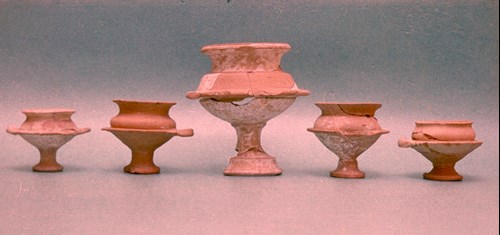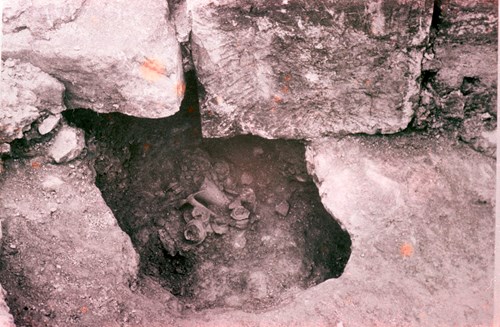“Its shape is peculiar and its use is not at all clear”. Thus did the archaeologist Dimitrios Philios attempt to describe to the readers of the Archaeologiki Ephimeris (Archaeological Gazette) a series of strange clay vessels discovered approximately two metres beneath the floor of the porch of the Telesterion constructed by Philon in Eleusis. The vessels were covered with “kotyliskous” and were found in a thick layer of ashes. Philios knew that there were two types of vessels associated with the Eleusinian Mysteries: the kernos and the plemochoe. But this did not help him at all. The mysterious objects he had discovered could not be used for the transportation of liquids (like a plemochoe) or any other obvious practical purpose. Faced with the unknown, Philios interpreted them as thymiateria (incense burners).

Deposit of plemochoai (kernoi) buried under the Late Roman fortification wall, vessel, American School of Classical Studies / Athenian Agora Excavations © American School of Classical Studies at Athens, Archives, Athenian Agora Excavations
Philios’ conundrum was perfectly justified. Until 1885, when the archaeological research in Eleusis brought these vessels to light, nobody had seen a kernos since the end of antiquity. Researchers could only find relevant information in a passage by the ancient Greek rhetorician and grammarian Athenaeus, who described the kernos as a clay vessel having many little cups (kotyliskoi) full of various offerings (sage, white poppy, wheat, barley, pulse, lentils, wine, milk, and sheep’s wool). A priest distributed these contents to those who carried the kernos, who then tasted these contents like a liknophoros. The discovery of the Ninnion Tablet in Eleusis in 1895 solved the problem. The main panel of the tablet depicts three women who carry the vessels found by Philios a decade earlier.
The word kernos may originate in another word meaning “rough” (κέρχνος), a reference to the multitude of small kotyliskoi which give the surface an uneven appearance. The kernos was used in the rites of chthonic deities (Rhea, Kybele) but became almost synonymous with the Mysteries of Demeter in Eleusis. There were various types of kernos in a range of materials (terracotta, stone, bronze) but the basic form remains the same. It is a vessel with a conical base and a body in two sections. The lower section flares out to a horizontal flange with a variable number of holes pierced through it and two handles projecting from it. The upper part curves inwards but it has a wide mouth with an out-rolled rim. The kernos was usually painted, while the most lavish vessels had a thin covering of gold leaf.
Most kernoi in Attica come from Eleusis or the City Eleusinion in the northern slope of the Athenian Acropolis. This is an indisputable testament to its importance for the cult of Demeter. According to a theory, the initiates used the kernoi to carry a small sample of the bountiful vegetable, fruit, and livestock products provided by the goddess. The Ninnion tablet is evidence that the kernoi were used in the so-called “kernophoria”, a ritual dance performed by women carrying kernoi on their heads around the Kallichoron well on the night the procession of the Greater Mysteries arrived in Eleusis.

View of deposit of plemochoai (kernoi) buried under the Late Roman Fortification Wall. Deposit T 22:1, photograph, American School of Classical Studies / Athenian Agora Excavations © American School of Classical Studies at Athens, Archives, Athenian Agora Excavations






